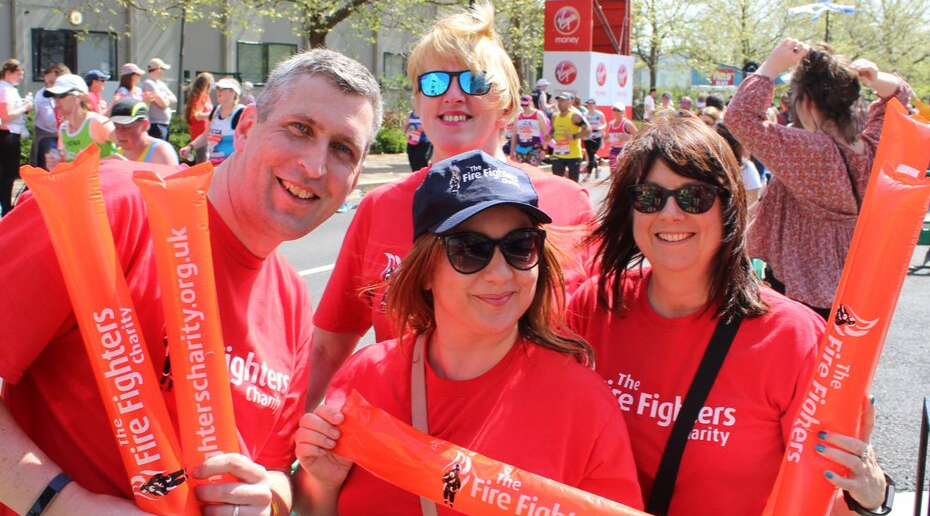Which platform do I pick?
We’re going to focus on JustGiving, Facebook Fundraising and Peoples Fundraising but there are others out there that you can use and they all work in a similar way. JustGiving is the most widely-used platform for online giving as it’s so easy to use. However, you can only select one charity at a time to raise money for, so if you wanted to split your funds between us and another cause close to your heart, People’s Fundraising might be the better option for you, as you’re in control of the percentage split.
How do I set up a personal page?
Both platforms have simple set-up instructions, so you’ll just need to register your details and state that you’re doing this on behalf of a charity, not an individual (this is important, as only charities can claim Gift Aid), then search for and select Fire Fighters Charity. Follow the steps through, upload a photo or two of yourself and write some information, and you’re away.
You can create a QR code for your JustGiving page by going to your page and adding ‘/qrcode’ to the end of the URL.
Create a page for our Fire Family Fundraiser JustGiving Campaign
What do I say about myself?
Once you’ve completed the basic questions, there’s space to write a bio about you and your reasons for taking on this challenge. You can say as much or as little about your motivations for choosing Fire Fighters Charity, but remember, the more inspirational detail you share, the more people are likely to be moved to donate. Ask yourself…
– What’s my connection to the fire service?
– Have I ever been supported by the charity myself? If so, why and what impact did it have?
– Do I know anyone else who has been supported by the charity?
– Am I doing this in honour of any particular person? If so, what are or were they like?
– Why this particular challenge? What does it mean to me?
– What training will I have to undertake this challenge?
– Why should people sponsor me?
What do I say about the charity?
If you’re not certain exactly what we do, we’ve got a simple statement you can use on your online pages:
What if I’m part of a team?
If you’re taking part as a team, you have two options. Either, instead of setting up a personal page, you create a team page, clearly named to make it clear this is a group effort. This is important, as people being linked to your page may not realise and think it’s your personal page. Bear in mind, if you do this option, it still needs one name to associate it to, so it will say “Joe Bloggs is fundraising for Fire Fighters Charity” in the website description.
How to create a team page on JustGiving
Alternatively, you can create a mass of personal pages and link these to one team page. This needs an admin to set it up and manage. Someone who can send invitations to other members of the team. This is better than leaving it public, as anyone might try to join, which will muddle your fundraising total.
Remember, even if you’re part of a team, you should still include your motivation for choosing to fundraise for Fire Fighters Charity.
What picture should I use?
We’ve got a choice of banner images to use that you can use on your online donation pages. You can find them here. It’s better to use one of these than the stock images available, because when people share it online, this picture will be the first thing they see. Feel free to change the image throughout your fundraising, to keep it interesting for you and your followers.
What fundraising target should I set?
That’s personal to you really, and also to the challenge you’re setting yourself. Certain events will have set targets – like the London Marathon where runners are asked to raise a minimum of £2,000 – but if you’re setting a target yourself, it’s best to be realistic. Better to be pleasantly surprised how quickly you met your target of £500 and then extend it if you’d like, than to feel glum about not being as close as you’d like to the £5,000 you were sure you’d make. Plus donors like to feel like they’re making a difference and see their contribution jump up towards your target. Trust us when we say it makes the early morning training sessions in the rain a lot easier if you’re closer to your fundraising target.
Should I update on my progress?
Definitely! Post photos, videos or blog entries about how you’re doing. Link to the page from everywhere, and be savvy in how you’re using content. Just uploaded a brilliant photo of your mud-caked trainers to Instagram? Post it to your JustGiving page at the same time, so people can see it’s a dynamic thing that you’re putting effort into. Then they might be more inspired to donate, feeling like they’re part of your story.
If you’re using a fitness tracker like Strava or Fitbit you can connect it to your JustGiving page to automatically share the progress of your training and the your challenge. This is a great way to share progress updates especially for longer challenges like multi-day treks and bike rides, allowing your supporters to join your fundraising journey.
How to connect a fitness app to your JustGiving page
How do I get my page out there?
One of the best things about online donation pages is how easily and quickly you can share them. Post them on your social media, ask friends to share them, link to your blog posts on the page and just generally get it out anywhere you think people will be receptive to it. Got a work newsletter that goes out? See if you can get it featured in there? Or can you adjust your email signature to include a link to it for a while?
That being said, people will quickly become unimpressed if their social media page is suddenly swamped with links to your page. It’s a careful balance between telling people what you’re up to and asking for their money.
Make some of your updates fun. If you’ve just been soaked in the rain and got lost while out for a run, sorry, but we want to see a picture of you looking drenched. If people are going to donate, the least you can do is show them just how much effort you’re putting in!
You can balance these with sharing the reasons for doing it, talk to the camera about how far you’ve come while you’re out for a walk, or post our case studies because you want people to see why you’re going to so much effort and where their donation goes.
And think about the time of day you’re posting updates. People are much more likely to get their debit card out if they’re sitting down with a cup of tea on a Sunday afternoon than if they’re running for a train first thing on a Monday.
We find the closer it gets to the event, the more people are likely to be donating. One week to go? Post a link. Enjoying your last meal before the event? Post a link. Heading off to the starting line? Post a link.
How does money get to you?
Once they’ve been set up, money raised on all platforms comes to us each month without you or us having to do a thing. We told you they were easy to use! Gift Aid is also paid directly to the charity, once it’s been approved. Please note that charities are charged administration fees by both JustGiving and People’s Fundraising to cover the cost of maintenance and development. This is the case with many of online donation platforms. You can find out more about their fees on the JustGiving, Facebook and People’s Fundraising websites.
That’s about it for online donation pages. But don’t forget you can find plenty of other tips in our Fundraising Toolkit.
What should I do after the event?
When you’re setting up your page, you’ll be asked for a closing date for funds. While it may be tempting to leave it open for months afterwards in case more donations come in, we suggest closing your page one month after your event, as actually more people are likely to donate in the immediate aftermath of your event. Plus we get a notification when the page closes, which will help us to promote your efforts to our followers. It would be helpful to update your page to say you’ve done it, just in case anyone comes across it later. But in terms of transferring money to us, don’t worry, it all comes to us automatically.




